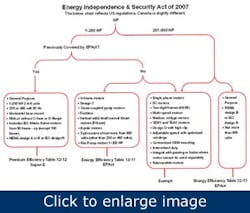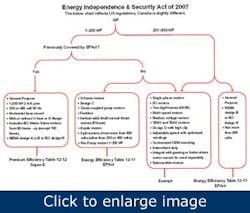Maintenance managers should plan for effects of new EISA motor standards
The new motor standards set forth in the Energy Independence and Security Act of 2007 (Public Law 14-110, EISA) went into effect on Dec. 19. The legislation regulates the types of motors produced for sale in the United States, requiring new 1-200 hp electric motors to meet NEMA Premium Efficiency standards. EISA also covers imported motors as well as the efficiency of motors on equipment.
“The proposed Canadian standard went in effect Jan. 1,” explains John Malinowski, senior product manager, Baldor Electric. “The European standards to go to Eff2 will be in June, and Mexico will be later in 2011.”
The U.S. law is an extension of the Energy Policy and Conservation Act of 1992 (EPAct 92) and EPAct 2005, which required new federal motor purchases to meet NEMA Premium Efficiency ratings for 1-200 hp general purpose motors.
“The law is really for the motor manufacturers, not the end user,” explains Malinowski. “It regulates the motors that we’re allowed to manufacture. This is a follow-on law to EPAct 92, which went into effect in 1997. The 2005 legislation dealt primarily with which motors federal entities had to buy.”
Depending on the type and size, 1-500 hp motors now must meet minimum, nominal, full-load efficiency ratings. What this means is that standard efficiency motors that many plants might be running will no longer be available and ultimately will need to be replaced with NEMA Premium Efficiency motors. But plant maintenance personnel still can use the standard efficiency motors.
“They can use those motors,” says Malinowski. “They can repair those motors. With motors built before Dec. 19, they can do whatever they want to do with them. And any distributors that have them in inventory can still sell them.” But eventually a change to NEMA Premium Efficiency motors is inevitable and could save significantly on energy costs. The initial cost of the upgrade will be slightly higher, which might surprise many procurement departments.
“We reward purchasing agents for saving money on the first cost,” explains Malinowski. “Their job has typically been to go out and find the least expensive widget, and we reward them for that. But energy efficiency costs money. It costs more money to build a Premium Efficiency motor than it does to build one that isn’t. More than 97% of the total cost of a motor is the life costs or energy costs. Only 2% of the cost is the initial price.”
To perform at a higher level of efficiency, more advanced materials are required and more copper is required. Those increased material costs, on average, will result in a 15% to 30% higher purchasing price than standard efficiency motors, according to www.themotorspecialist.com, a site managed by Motion Industries, an industrial MRO parts distributor. The site is designed to help with navigating the new requirements and offers EISA tools and calculators to help with identifying the best replacement motor or calculating cost savings by upgrading to Premium Efficiency motors.
“The best thing to do is, as motors fail, replace them instead of repairing them,” suggests Don Lanser, director of industrial marketing at Nidec. “And, depending on the life cycle of the motor and the payback, you might want to do that before it fails. But how do you get people to take out something that works perfectly well?”
The new motors should run cooler and last longer, says Lanser. “It also means they should not have to change the bearing grease as often with the new motors. There are three issues that the users need to know about the new motors.”
As you increase the efficiency of the motor, you reduce the slip, he explains. “A motor that was not a NEMA Premium may operate at 1,745 rpm, and one that is NEMA Premium would operate at 1,755 or faster, so you may have to figure out how to slow it down a little bit,” says Lanser. “If you’re operating on a drive, it’s not a big issue.”
A potential difference in the kVA code letter exists, as well. “You may need to review your motor starter size compatibility,” suggests Lanser.
“Finally, when people size motors, they assume they’ll operate them between 75 and 100% load,” he explains. “Make sure you’re not underloading the motor.”
Installing the right sized motor for the application saves on both first cost and life cycle cost, adds Malinowski.
Try this on for size
The biggest issue for the maintenance technician will be the replacement decision, says Randy Breaux, vice president of marketing at Baldor Electric. “If a customized motor fails and there’s no backup, then they have to make a decision,” he says. “Will the new motor fit in the same space that the old motor fit? Some will be bigger, so space constraint is an issue they might have to take into consideration.”
A motor buried inside a critical piece of equipment might require some forethought. “A little bit of legwork now might save them some pains later on,” suggests Breaux. “If I have to shut down my operation, I want to find out if I have a viable spare. If I don’t, I need to go back to the OEM or the distributor and purchase a motor that will fit in that space.”
[pullquote]The shaft size will be the same, but the length of the motor might be different, confirms Lanser. “If you had a 5-hp motor in a 180 frame, it’ll still be in the 180 frame,” he explains. “You have the same diameter and the same shaft type. And you’re going to get the same voltage carryover.”
But a plan needs to be in place. “Every instance is going to be different,” says Breaux. “The motors that are buried inside are the ones I’m going to look at first. Replacement and repair are the big issues to have a plan for. Take an assessment of all the motors in the plant.”
Also, because the inrush current that the new premium motor will draw might be higher, look at overload protection, says Breaux. “If the overload protection is at the limit, they might have to change the overload protection to accommodate the higher amperage. These are the things they need to have a plan in place for now, not when failure occurs.”
Be aware
Despite the legislation’s long history, many plants might still be unaware of its impact and the long-term cost benefits. “There still are a lot of people out there who don’t know what’s going on,” says Breaux. “EISA is going to affect everyone with equipment that has motors in it. There are a lot of end users out there who do not know what’s coming.”
Malinowski stresses that the economic benefits are even further out than what is covered by EISA. “What we need to do as a long-term goal is get away from energy efficiency by replacing single components,” he warns. “The Department of Energy has singled out the motor as a component, but, to really get significant energy savings, these are just small incremental bumps. If we look at a complete system, say a conveyor with a double-reduction worm gear box, I could replace that with a helical gearbox that’s 95% efficient. Whatever torque that gear was producing, the new gear needs less horsepower. We need to start looking at systems — not just putting that motor on the pump, but looking at the efficiency of the pump.”
Some energy-minded companies already have done the motor upgrades and are looking at where they go today. “Their low-hanging fruit has been taken,” warns Malinowski. “Even companies that have a proactive energy program do not take running motors out of the system until they’ve failed. It means having a good alliance with a good distributor and cleaning all the old motors out of the maintenance shed. Mark the motors so you know what to do with them before they fail. Make sure you replace with an upgrade because once it’s running, they won’t shut it down again until it fails.”

